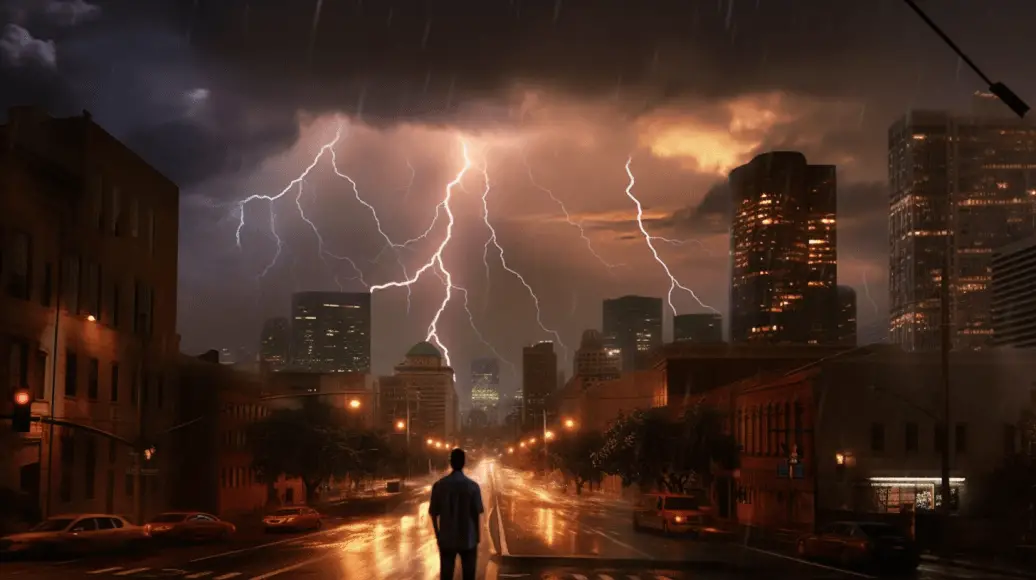Assessing the risk of lightning strikes is essential for any building or structure, as it can help prevent damage and injury.
Lightning risk assessment evaluates the likelihood of a lightning strike and the potential damage it may cause to a building and its surroundings. The study also determines whether the structure requires a lightning protection system to mitigate the risk of damage and injury.
The process of lightning risk assessment involves evaluating the location of the building, its height, and the materials used in its construction. Lightning strikes are more common in certain areas, and buildings located in such regions may require more extensive protection.
The height and materials used in construction can also play a role in determining the risk of lightning strikes and the potential damages that may result.
This can help you take the necessary steps to mitigate the risk of damage and injury caused by lightning strikes.
In the following sections, we will explore the different aspects of lightning risk assessment and how it can help protect your building from the dangers of lightning strikes.

Understanding Lightning
Lightning is a natural phenomenon caused by the buildup and discharge of electrical energy in the atmosphere.
It is a powerful force of nature that can cause significant damage to buildings and other structures and pose a serious risk to human life. This section will explore the nature of lightning and the different types of lightning strikes.
Nature of Lightning
Lightning is a sudden and powerful electrical discharge that occurs within a thunderstorm.
It is caused by the buildup of electrical charges within the atmosphere, which are generated by the movement of air currents and the collision of water droplets and ice particles.
Lightning can take many forms, including cloud-to-ground, cloud-to-cloud, and intra-cloud discharges.
The flash of lightning results from an electrical current passing through the air. This current can be as hot as 50,000 degrees Fahrenheit, which is hotter than the sun’s surface.
Lightning can travel up to 220,000 miles per hour and generate a shockwave that can be felt up to several miles away.
Lightning Strikes
Lightning strikes can be classified into two main types: direct and indirect strikes. A direct strike occurs when lightning hits a building or other structure directly.
An indirect strike occurs when lightning hits a nearby object, such as a tree or a power line, and the electrical current is conducted to the building or structure.
Direct lightning strikes are the most dangerous type of strike and can cause significant damage to buildings and other structures. They can also pose a serious risk to human life, as the electrical current can cause burns, cardiac arrest, and other serious injuries.
Indirect lightning strikes are less dangerous than direct strikes but can still cause significant damage to buildings and other structures. They can also risk human life, as the electrical current can travel through the ground and cause electrical shocks.
Lightning is a powerful force of nature that can pose a serious risk to human life and cause significant damage to buildings and other structures.
Understanding the nature of lightning and the different types of lightning strikes is important to develop effective lightning protection strategies.
Basics of Risk Assessment
Regarding lightning protection, risk assessment is a critical component in determining the level of protection needed for a particular facility.
Risk assessment involves identifying potential hazards, evaluating the likelihood of those hazards occurring, and determining the potential consequences of those hazards.
This section will cover the basics of risk assessment, including the components of risk and tolerable risk factors.
Risk Components
Risk assessment involves evaluating three components of risk: the probability of an event occurring, the consequences of that event, and the exposure or vulnerability of the facility to that event.
Probability
Probability is the likelihood of a lightning strike occurring at a particular location.
This can be determined by analyzing historical data on lightning strikes in the area and other factors such as the type of terrain and the height of nearby structures.
Consequences
Consequences refer to the potential damage or loss that could result from a lightning strike. This can include damage to the facility and any equipment or personnel.
Exposure or Vulnerability
Exposure or vulnerability refers to the level of risk that a facility faces due to its location, construction, and other factors.
For example, a facility located in an area with high lightning activity may be more vulnerable to lightning strikes than one with low lightning activity.
Tolerable Risk Factors
Once the components of risk have been evaluated, the next step is to determine the tolerable risk factors for the facility. Tolerable risk factors are the acceptable levels of risk that the facility can tolerate without suffering significant damage or loss.
Tolerable risk factors are determined by various factors, including the importance of the facility, the cost of implementing lightning protection measures, and the potential consequences of a lightning strike.
In general, facilities with high levels of importance or high potential consequences will have lower tolerable risk factors than facilities with lower levels of importance or lower potential consequences.
Risk assessment is critical in determining the level of lightning protection needed for a particular facility.
Evaluating risk components and determining tolerable risk factors, facility owners and safety professionals can ensure that their facilities are adequately protected from the risks of lightning strikes.
Lightning Risk Assessment
Lightning strikes can cause significant damage to buildings and their occupants. A lightning protection risk assessment evaluates whether a building and its surrounding environment are at risk of a lightning strike.
Process of Lightning Risk Assessment
The process of lightning risk assessment involves several steps. First, a qualified lightning protection specialist will assess the building and its surrounding environment to identify potential lightning strike hazards.
The specialist will then evaluate the risk of lightning strikes based on the building’s location, height, and other factors.
Next, the specialist will determine the level of protection required for the building. This may involve installing a lightning protection system, which typically includes lightning rods and conductors that redirect lightning strikes away from the building.
The specialist will also assess the need for surge protection devices, which protect electrical equipment from power surges caused by lightning strikes.
Evaluation and Report
After completing the lightning risk assessment, the specialist will provide a report that details the findings and recommendations. The report will typically include the following information:
- A summary of the assessment process and methodology used.
- A list of potential lightning strike hazards identified during the assessment.
- An evaluation of the risk of lightning strikes based on the building’s location, height, and other factors.
- Recommendations for lightning protection system and surge protection device installation, if necessary.
- A summary of the cost and benefits of implementing the recommended lightning protection measures.
It is important to note that lightning risk assessments should be conducted regularly, as the risk of lightning strikes can change over time.
As a general rule, it is recommended that buildings undergo a lightning risk assessment every five years.
In summary, lightning risk assessments are a critical component of building safety. By identifying potential lightning strike hazards and evaluating the risk of lightning strikes, these assessments can help protect buildings and their occupants from the damaging effects of lightning strikes.
Lightning Protection Measures
These measures include designing and installing a lightning protection system, installing lightning rods and grounding, and using surge protective devices.
Design and Installation
The design and installation of a lightning protection system are critical to ensure your building is properly protected from lightning strikes.
Lightning protection systems are designed to provide a safe path for lightning to follow, reducing the risk of damage to the building and its occupants.
The installation of a lightning protection system should be carried out by a qualified and experienced professional. The system should be designed according to international standards and installed in accordance with the manufacturer’s instructions.
The installation should be inspected and tested regularly to ensure it functions correctly.
Lightning Rods and Grounding
Lightning rods are an important component of a lightning protection system. They are designed to attract lightning strikes and provide a safe path for the lightning to follow.
Lightning rods should be installed at the highest point of the building and connected to a grounding system.
Grounding is also an essential component of a lightning protection system. It provides a low-resistance path for lightning to follow, reducing the risk of damage to the building and its occupants.
The grounding system should be designed and installed in accordance with international standards and inspected.
This needs to be tested regularly to ensure that it is functioning correctly.
Surge Protective Devices
Surge protective devices protect electrical equipment from voltage spikes caused by lightning strikes. They are installed at the point where electrical equipment enters the building and provide a barrier to prevent voltage spikes from damaging the equipment.
Surge protective devices come in different types and should be selected based on the voltage requirements of the equipment they are protecting.
They should also be installed by a qualified, experienced professional and inspected and tested regularly to ensure they function correctly.
In conclusion, lightning protection measures are essential to minimize the risk of damage and injury caused by lightning strikes.
Designing and installing a lightning protection system, installing lightning rods and grounding, and using surge protective devices, you can protect your building and its occupants from the devastating effects of lightning strikes.
Standards and Regulations
When it comes to lightning protection, there are several standards and regulations that you need to be aware of. These standards help ensure that your lightning protection system is installed correctly and adequately protects your building and its occupants.
NFPA 780
The National Fire Protection Association (NFPA) 780 is the primary standard for lightning protection in the United States.
This standard provides guidelines for installing, inspecting, and maintaining lightning protection systems.
NFPA 780 covers a wide range of topics related to lightning protection, including the design of lightning protection systems, the materials used in these systems, and the installation process.
It also guides assessing the risk of lightning strikes and determining the appropriate level of protection for your building.
IEC 62305
The International Electrotechnical Commission (IEC) Standard 62305 is another important standard for lightning protection.
This standard provides guidelines for designing, installing, and maintaining lightning protection systems for buildings and other structures.
IEC 62305 is divided into several parts, each covering a different aspect of lightning protection. Part 2 of the standard, for example, guides how to assess the risk of lightning strikes and determine the appropriate level of protection for your building.
National Fire Protection Association
The National Fire Protection Association (NFPA) is a non-profit organization that develops and publishes standards related to fire safety. NFPA 780 is just one of the many standards the organization has developed over the years.
The NFPA is an important resource for anyone involved in the design, installation, or maintenance of lightning protection systems.
The organization provides a wide range of resources related to lightning protection, including training programs, webinars, and other educational materials.
IEC Standard 62305-2
IEC Standard 62305-2 is a specific part of the IEC 62305 standard that covers the risk assessment process for lightning protection systems.
This standard guides you to assess the risk of lightning strikes and determine the appropriate level of protection for your building.
IEC Standard 62305-2 is an important resource for anyone involved in the design, installation, or maintenance of lightning protection systems.
It provides a detailed framework for assessing the risk of lightning strikes and determining the appropriate level of protection for your building.
Assessing Lightning Risk for Different Structures
When assessing lightning risk for different structures, it’s important to consider the type of structure, its contents, and its occupancy. Hospitals, nursing homes, schools, and residential buildings all have unique risk factors.
Hospitals and Nursing Homes
Hospitals and nursing homes are critical structures that require special attention regarding lightning protection.
These facilities typically have a higher occupancy rate and may have patients particularly vulnerable to power outages. It’s important to assess the risk of lightning strikes to critical equipment, i.e. life support systems, and fire risk from lightning strikes.
Schools
Schools are another type of structure that requires careful lightning risk assessment. In addition to the safety of students and staff, expensive equipment such as computers and lab equipment may need to be protected.
Additionally, schools may have large outdoor areas, such as sports fields, that require protection.

Residential Buildings
Residential buildings are typically lower-risk structures, but lightning strikes can still cause significant damage to the building and its contents.
It’s important to assess the risk of fire from lightning strikes and the risk of damage to electrical systems and appliances.
When assessing lightning risk for any structure, it’s important to consider the contents of the structure as well as the occupancy.
Critical equipment such as hospital life support systems and expensive lab equipment in schools should be given special attention. Additionally, outdoor areas such as sports fields should be protected.
Assessing lightning risk and implementing appropriate lightning protection measures, you can help ensure the safety of the occupants and protect the structure from damage.
Environmental Factors and Lightning Risk
Environmental factors play a significant role in determining the likelihood of a lightning strike when it comes to lightning risk assessment. Two key factors to consider are ground flash density and the surrounding environment.
Ground Flash Density
Ground flash density (GFD) is a measure of the number of lightning strikes per square kilometer per year. This metric assesses the likelihood of a lightning strike occurring in a given area.
Areas with higher GFD are at greater risk of lightning strikes and require more robust lightning protection systems.
Flash density maps are used to determine the GFD of a specific area. These maps provide a visual representation of the frequency of lightning strikes in a given location.
Analyzing these maps, you can identify areas with higher GFD and adjust your lightning protection measures accordingly.
Surrounding Environment
The surrounding environment of a structure can also impact the likelihood of a lightning strike. The coefficient of the surrounding environment (C1) is used to evaluate the impact of the surrounding environment on the risk of a lightning strike.
Isolated structures located on hilltops or mountains are at greater risk of lightning strikes than structures located among similarly sized structures.
This is because isolated structures are likelier to be the area’s tallest objects, making them more attractive to lightning.
Other factors that can impact the surrounding environment include the presence of trees, bodies of water, and other tall structures.
These factors can increase or decrease the likelihood of a lightning strike and should be considered when conducting a lightning risk assessment.
Consequences of Lightning Strikes
Lightning strikes can have serious consequences, including injury and loss of life, damage to structures, and liability.
It is important to assess the risk of lightning strikes in your area and take appropriate measures to protect yourself and your property.
Injury and Loss of Life
According to the CDC, lightning strikes caused an average of 28 deaths annually in the United States from 2006 to 2021.
While the risk of being struck by lightning is low, the consequences of lightning strike injuries are serious. Lightning can cause burns, cardiac arrest, and other serious injuries.
Damage to Structures
Lightning strikes can also cause significant damage to structures. The electrical current from a lightning strike can damage electrical systems, start fires, and damage roofs, walls, and other building parts. This can lead to costly repairs and downtime for businesses.
Liability
If someone is injured or killed by a lightning strike on your property, you could be liable for damages. It is important to reduce the risk of lightning strikes and ensure your property is safe for visitors and employees.
It is important to conduct a lightning risk assessment to mitigate the risks of lightning strikes.
Factors influencing the risk of lightning strikes include areas with a lot of human traffic, institutions that offer essential services, regions that experience regular lightning flashes, isolated buildings, and facilities that store flammable items.
Identifying areas of high risk, you can take appropriate measures to protect yourself and your property from the consequences of lightning strikes.
Conclusion
Lightning risk assessment is an important process that helps evaluate the possibility and probability of lightning strikes on a building or facility.
In conducting a thorough assessment, you can identify the risks and determine whether a lightning protection system is necessary to mitigate the risk of damage and injury.
During the assessment, it is important to consider various factors such as the location of the building, the type of structure, and the materials used in construction. These factors can affect the likelihood of a lightning strike and the potential damage that can occur.
To conduct a proper risk assessment, it is recommended to follow international standards and guidelines such as those provided by the National Fire Protection Association (NFPA) and the International Electrotechnical Commission (IEC).
These standards provide a framework for evaluating the risk and determining the appropriate level of protection needed.
Regarding lightning protection, various systems and technologies are available to help mitigate the risk of damage and injury.
These include lightning rods, surge protectors, and grounding systems. The choice of system will depend on the specific needs of the building and the level of protection required.
Lightning risk assessment is a critical process that should not be overlooked.
Frequently Asked Questions
What factors are considered in a lightning risk assessment?
A lightning risk assessment evaluates the risk of a lightning strike to a building and its surrounding environment.
The assessment considers factors such as the building’s height, location, construction materials, and the presence of electrical and electronic systems. The assessment also considers the frequency and intensity of lightning strikes.
How can I perform a lightning risk assessment for my building?
To perform a lightning risk assessment, you hire a professional lightning protection company or consultant.
The company will evaluate the building and its surrounding environment to determine the risk of a lightning strike. Alternatively, you can use lightning risk assessment software to perform a self-assessment.
What are the common methods used for lightning risk assessment?
The common methods used for lightning risk assessment include the rolling sphere, mesh, protection angle, and finite element methods.
The rolling sphere method is the most commonly used and involves rolling a sphere over the building to determine the areas at risk of a lightning strike.
What is the importance of a lightning risk assessment report?
A lightning risk assessment report provides valuable information on the risk of a lightning strike to a building and its surrounding environment.
The report includes recommendations for installing a lightning protection system to mitigate the risk of damage and injury. The report also provides information on the expected performance of the lightning protection system.
What are the hazards associated with lightning strikes on buildings?
Lightning strikes on buildings can cause damage to the building’s structure and electrical and electronic systems.
The strikes can also cause fires and explosions. In addition, lightning strikes can cause injury or death to people in and around the building.

What are the key features to look for in lightning risk assessment software?
When choosing lightning risk assessment software, look for software that is easy to use and provides accurate results.
The software features include a rolling sphere, mesh, and protection angle methods. The software should also provide detailed reports with recommendations on installing a lightning protection system.

Chris Ekai is a Risk Management expert with over 10 years of experience in the field. He has a Master’s(MSc) degree in Risk Management from University of Portsmouth and is a CPA and Finance professional. He currently works as a Content Manager at Risk Publishing, writing about Enterprise Risk Management, Business Continuity Management and Project Management.


